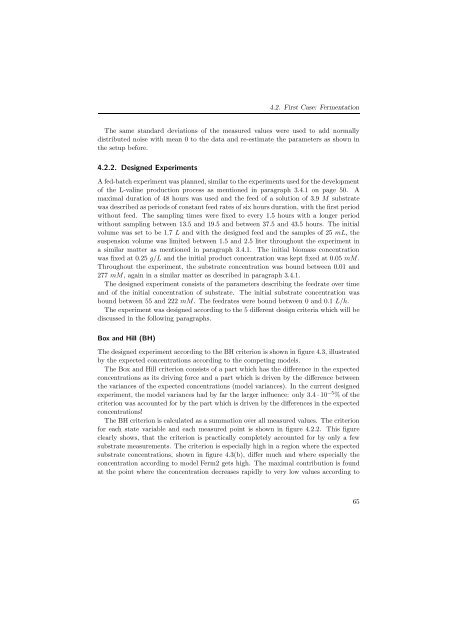Corynebacterium glutamicum - JUWEL - Forschungszentrum Jülich
Corynebacterium glutamicum - JUWEL - Forschungszentrum Jülich
Corynebacterium glutamicum - JUWEL - Forschungszentrum Jülich
You also want an ePaper? Increase the reach of your titles
YUMPU automatically turns print PDFs into web optimized ePapers that Google loves.
4.2. First Case: Fermentation<br />
The same standard deviations of the measured values were used to add normally<br />
distributed noise with mean 0 to the data and re-estimate the parameters as shown in<br />
the setup before.<br />
4.2.2. Designed Experiments<br />
A fed-batch experiment was planned, similar to the experiments used for the development<br />
of the L-valine production process as mentioned in paragraph 3.4.1 on page 50. A<br />
maximal duration of 48 hours was used and the feed of a solution of 3.9 M substrate<br />
was described as periods of constant feed rates of six hours duration, with the first period<br />
without feed. The sampling times were fixed to every 1.5 hours with a longer period<br />
without sampling between 13.5 and 19.5 and between 37.5 and 43.5 hours. The initial<br />
volume was set to be 1.7 L and with the designed feed and the samples of 25 mL, the<br />
suspension volume was limited between 1.5 and 2.5 liter throughout the experiment in<br />
a similar matter as mentioned in paragraph 3.4.1. The initial biomass concentration<br />
was fixed at 0.25 g/L and the initial product concentration was kept fixed at 0.05 mM.<br />
Throughout the experiment, the substrate concentration was bound between 0.01 and<br />
277 mM, again in a similar matter as described in paragraph 3.4.1.<br />
The designed experiment consists of the parameters describing the feedrate over time<br />
and of the initial concentration of substrate. The initial substrate concentration was<br />
bound between 55 and 222 mM. The feedrates were bound between 0 and 0.1 L/h.<br />
The experiment was designed according to the 5 different design criteria which will be<br />
discussed in the following paragraphs.<br />
Box and Hill (BH)<br />
The designed experiment according to the BH criterion is shown in figure 4.3, illustrated<br />
by the expected concentrations according to the competing models.<br />
The Box and Hill criterion consists of a part which has the difference in the expected<br />
concentrations as its driving force and a part which is driven by the difference between<br />
the variances of the expected concentrations (model variances). In the current designed<br />
experiment, the model variances had by far the larger influence: only 3.4 · 10 −5 %ofthe<br />
criterion was accounted for by the part which is driven by the differences in the expected<br />
concentrations!<br />
The BH criterion is calculated as a summation over all measured values. The criterion<br />
for each state variable and each measured point is shown in figure 4.2.2. This figure<br />
clearly shows, that the criterion is practically completely accounted for by only a few<br />
substrate measurements. The criterion is especially high in a region where the expected<br />
substrate concentrations, shown in figure 4.3(b), differ much and where especially the<br />
concentration according to model Ferm2 gets high. The maximal contribution is found<br />
at the point where the concentration decreases rapidly to very low values according to<br />
65

















